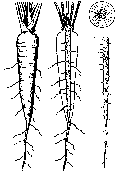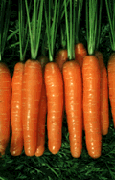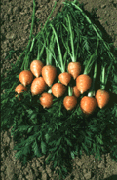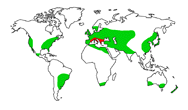Carrot (Daucus carota L.)
Carrot family
(Apiaceae)

| 

|
| Schematic diagram of a carrot
| Different carrot varieties
with xylem removed
|
Source: Becker J., Gemüsebau, Verlag Paul Parey 1956; Wolf-Garten
Distribution, Yield, Use:
Production (1000t) Yield (dt/ha)
| Country | 1979-81 | 1992 | 1979-81 | 1992
|
| China | 1790 | 2930 | 184 | 223
|
| ex-USSR | 1910 | 1990 | 140 | 131
|
| USA | 980 | 1440 | 298 | 336
|
| Poland | 600 | 670 | 210 | 210
|
| Japan | 600 | 640 | 248 | 278
|
| UK | 650 | 800 | 442 | 442
|
| World | 10410 | 14030 | 204 | 223
|
- Distribution:
Grown world-wide in temperate and subtropical
regions, mainly in Europe, Syria to Afghanistan,
Pakistan, India, China, North America, Siberia
and North Africa.
Low soil requirements, sensitive to poor drainage.
- Use:
Foodstuff
(raw, cooked, as juice)
Carotin extraction
Fodder plant
4-10% sugar, 8 mg carotin,
6 mg vitamin C/100 g in the root.

Region of origin:  Region of cultivation:
Region of cultivation: 
- Cultivation and Breeding:
The carrot occurs in mid Europe as a wild plant with a thin whitish, woody tap-root. It is assumed that the garden carrot arose from a cross between the wild carrot and the giant carrot (Daucus maximus), found in the mediterranean area. The fleshy, fattened yellow-red root was a new characteristic. Through breeding, varieties arose which vary from about 20 cm long, through medium sized conical shapes to varieties with short, round roots. There are early, medium to early, late and perennial varieties.
- Breeding aims:
In the forefront are yield and quality characteristics.
Tenderness, a high amount of desirable contents (carotin, sugar), uniform colour of skins and flesh, shape and size of the root, and smooth peeling are important criteria.
Text by
Wolfgang Schuchert
Adapted to HTML by R.Saedler


